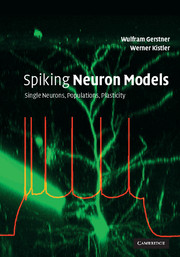Book contents
8 - Oscillations and synchrony
Published online by Cambridge University Press: 05 June 2012
Summary
Oscillations are a prevalent phenomenon in biological neural networks and manifest themselves experimentally in electroencephalograms (EEG), recordings of local field potentials (LFP), and multiunit recordings. Oscillations of the spike activity are particularly interesting from a functional point of view. Synchronization of different populations of neurons has, for example, been proposed as a potential solution to the binding problem (Eckhorn et al., 1988; Gray et al., 1989; Wang et al., 1990; König and Schillen, 1991; Eckhorn et al., 1993; Singer, 1994). Oscillations play an important role in the coding of sensory information. In the olfactory system an ongoing oscillation of the population activity provides a temporal frame of reference for neurons coding information about the odorant (Laurent, 1996; Desmaison et al., 1999). Similarly, place cells in the hippocampus exhibit phase-dependent firing activity relative to a background oscillation (O'Keefe, 1993). Finally, rhythmic spike patterns in the inferior olive may be involved in various timing tasks and motor coordination (Llinás, 1991; Welsh et al., 1995; Kistler et al., 2000).
In this chapter we do not discuss all the interesting computational applications, but restrict ourselves to the analysis of mechanisms underlying oscillatory activity and synchronization. We start in Section 8.1 with a stability analysis of the state of asynchronous firing encountered in Section 6.4. In recurrent networks of spiking neurons we find that a state of asynchronous activity is unstable in the absence of noise.
- Type
- Chapter
- Information
- Spiking Neuron ModelsSingle Neurons, Populations, Plasticity, pp. 285 - 314Publisher: Cambridge University PressPrint publication year: 2002



